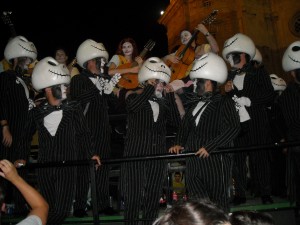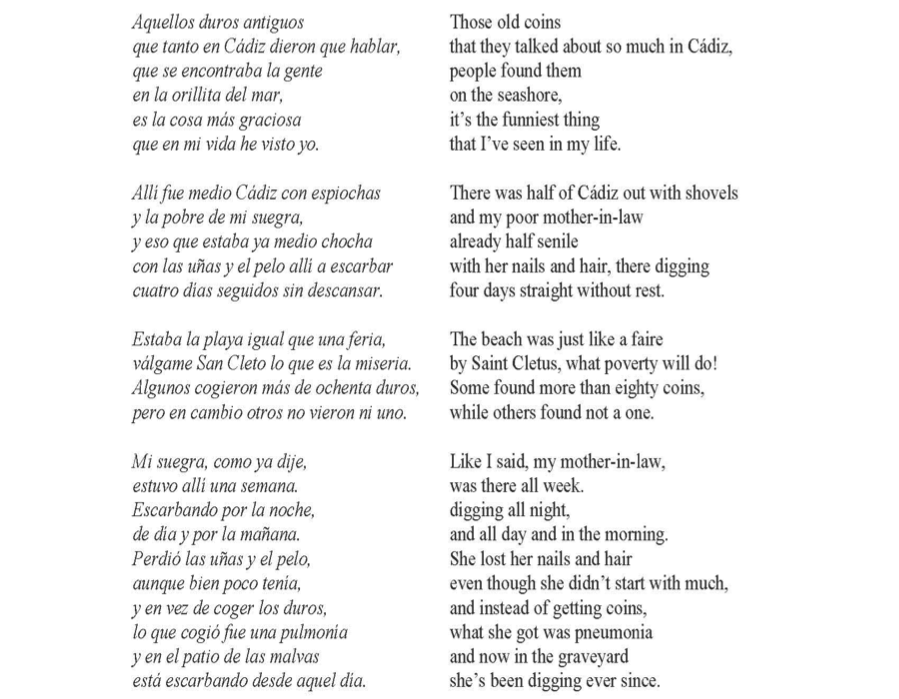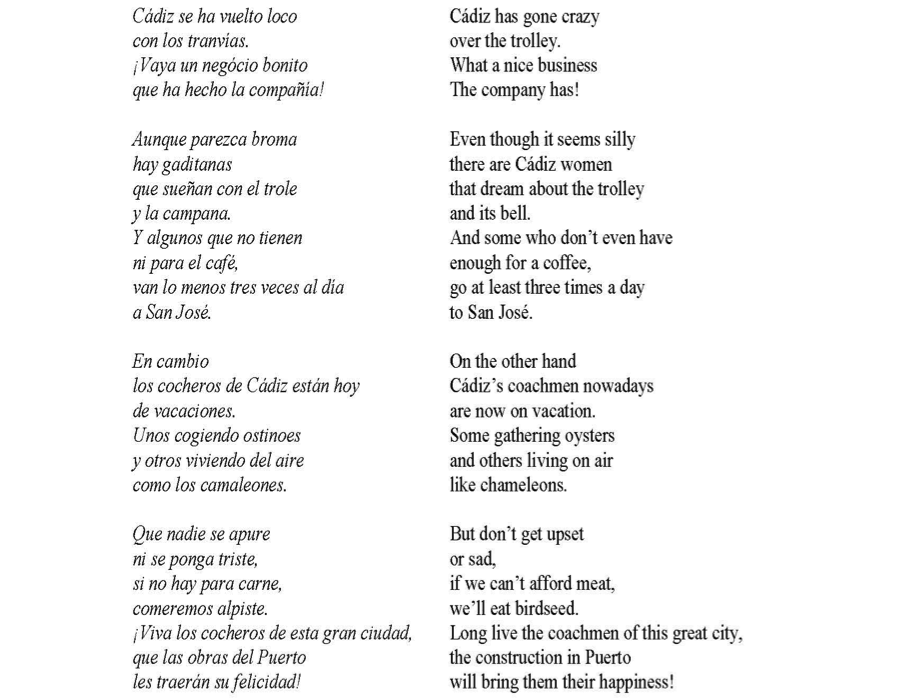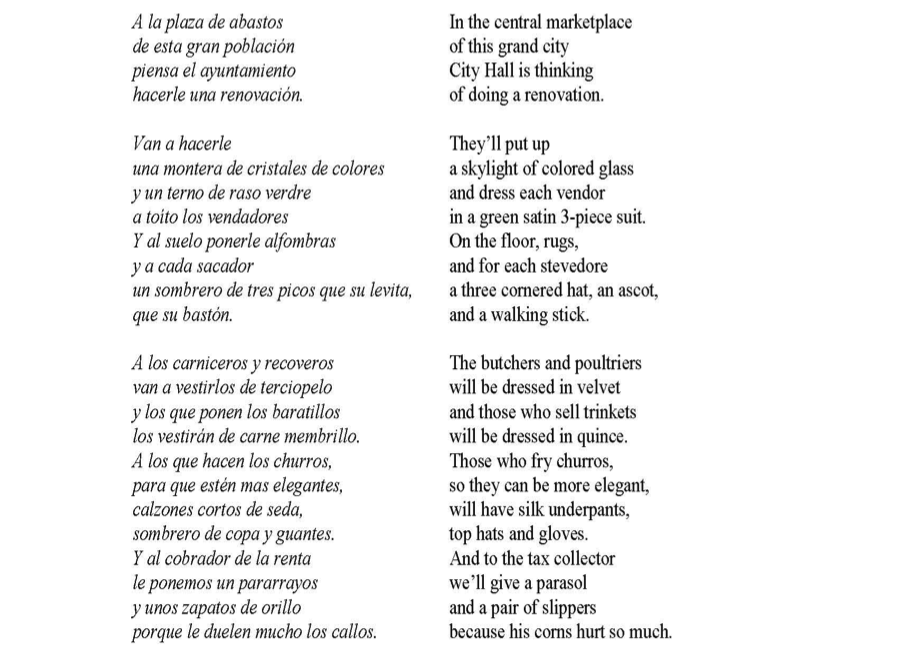When one thinks of Carnival it brings up images of sambas in Rio de Janiero, or beads and confetti in the New Orleans’s Mardi Gras. Most closely associated with Catholic culture, Carnival is the last bash before Lent. While some suggest pre-Christian origins in a bacchanalian tradition, one of the earliest Carnivals was celebrated in medieval Venice. Whatever the origin, and where ever it is celebrated, Carnival is typically a large street party, involving costumes, masks, music, and large amounts of alcohol.
Carnival is not limited to Brazil, New Orleans, and Venice – it is celebrated in many other places, including a unique Carnival in Cádiz, Spain. This one lasts 10-11 days, from the Thursday before Ash Wednesday to the Sunday following Ash Wednesday (Domingo de Piñata). Thus, rather than centering on the Tuesday before Lent (‘Fat Tuesday’), Cádiz continues its celebration into the first few days of Lent.
Carnival in Cádiz
Cádiz is a small city on an island close to Spain’s southern Atlantic coast. It is perhaps the oldest city in Western Europe, founded as a Phoenician trading outpost around 1100 BC. Cádiz has enjoyed periods of prosperity, followed by years of decline. Trade with the Americas peaked during the 18th and 19th centuries, allowing for an urbane, liberal, and cosmopolitan culture to develop. It was the site of Spain’s first liberal constitution in 1812. It is also known for its unique brand of irreverent humor; as the city fell on hard times during the late 19th and 20th centuries, this humor became more pointed, and sometimes takes on an ironic ‘gallows’ aspect; the following verse is typical:
Nonetheless, the Cádiz humor, or la gracia gaditana, combined with acerbic political satire, is the essence of its Carnival celebrations.
The Carnival in Cádiz is thought to be based on the Venetian Carnival. The prosperity the city enjoyed from its transatlantic trade in the 18th and 19th centuries brought a number of Venetian and Genoese merchants to settle in the city. By the late 19th century, Carnival took shape as centered around costumed singing groups: coros, chirigotas, comparsas, … (the distinctions between these are technical and the terms not always applied consistently). Each year these groups choose a name associated with a theme (tipo). Their costumes reflect this theme, as does the subject matter of the songs they sing.
The songs, always humorous and sometimes racy, cover several themes, including political satire, wry commentary on popular culture, and praises of Carnival and Cádiz (particularly the prototypical neighborhood of La Viña). This is serious business in Cádiz – the groups practice all year and spend considerable time and money putting together elaborate costumes. Cádiz boasts several costume shops that sew to order. Many groups complete in an official contest that takes place in the Teatro de Falla, while others – the comparsas ilegales – perform only on the street.
The history of the Cádiz Carnival can be divided into three important periods: The late 19th-early 20th century, the Franco period, and the post-Franco democracy.
As mentioned above, the Carnival took shape during the late 19th and early 20th centuries. This was the period of famous groups such as Las Viejas Ricas (‘the old rich ladies’), Los Antecuarios (‘the antique dealers’), and Los Cooperativos (‘the cooperatives’). The major figure from this period was Antonio Rodríguez Martínez “El Tío de la Tiza” (‘Chalk Guy’ – so named because he worked at a bar where tabs were computed on the bar with chalk). His most famous song was performed first in 1905: Los Duros Antiguos (‘the old coins’) which, composed for Los Anticuarios, spoofed the clamor that ensued when Mexican treasure washed up on a Cádiz beach in 1904. This has become the proto-type of a Carnival tanguillo (see below), and is the unofficial anthem of Cádiz. There is a plaza in the La Viña neighborhood named for El Tío de la Tiza.
Colorful descriptions of the Carnival from this early period are found in a unique book of oral history. Flamenco researcher José Luis Ortiz Nuevo launched a project in the early 1970s, where he recorded the famous Cádiz singer, Pericón de Cádiz, telling his many humorous stories. Published as Mil y una historias de Pericón de Cádiz (‘1001 Stories of Pericón de Cádiz’), this has become a classic in the flamenco literature, and one of the first of many flamenco oral histories. I recently translated this book to English, with copious footnotes and appendices to explain historical and cultural references. It should be released soon by Inverted-A Press.
Carnival was banned in Cadiz during the Franco dictatorship. The political satire was risky and the Catholic Church had always disapproved. While the city was in mourning following a horrible munitions explosion in 1947, the civil governor, Carlos María Rodríguez de Valcárcel, allowed a Carnival-like fiesta to take place under the name Fiestas Típicas de Cádiz. To appease the Church, it took place in May, rather than before Lent. The political satire from this period was heavily censured, but still came through by using clever double-meanings. The major figure from this period was Francisco Alba Medina ‘Paco Alba’, who participated from 1953 to 1975. His statue overlooks the famous Caleta beach.
The Fiestas Típicas continued until 1976, Carnival returned to its pre-Lenten dates in 1977; in 1978, on the Sunday before Ash Wednesday, a mock funeral procession buried the Fiestas Típicas, marking the return of the Cádiz Carnival. Since the return of democracy, the Carnival has flourished in a “no holds barred” manner. For example in 2006 a group, Los Pishas de Cádiz (‘the Cádiz dicks’), dressed as penises.[1]
Carnival to Flamenco
Cádiz is famous for its flamenco – the music and dance form from Andalucía. The Carnival and flamenco subcultures are distinct, but overlap. There has been mutual influence in both directions; here I will describe how Carnival music has made its way into the flamenco repertoire of Cádiz.
First, a bit about flamenco: flamenco is a music that developed from the popular music of Andalucía in professional venues during the 19th and 20th centuries. It is an oral tradition – the music is not traditionally written; rather, it is passed down in pedagogical contexts, sometimes within families. Flamenco is closely associated with the Andalucían Gitano (Gypsy) community, although many non-Gitanos participate as well. Flamenco typically involves singing (cante), guitar (toque), and dance (baile). Flamenco does not have specific songs; rather, there are some 50+ song forms (palos), each with its characteristic rhythm and melodic structure. Therefore, each performance of a particular form may be quite different form the last – it depends on the proclivities of the artist and the mood they find themselves in. Each form has a name; the two most closely tied to Carnival are tanguillos and bulerías.
Tanguillos
Carnival groups compose and perform a variety of song types; one of these is the tango de Carnaval or the tanguillos. These are unrelated to the Argentinian tango – they have a distinctive 6/8 rhythm and are generally in the major or minor keys (see the Duros antiguos clip, above). This song form has been incorporated into the flamenco repertoire, where tanguillo counts as one of the song forms, albeit, a fairly minor one. Several flamenco singers have performed Carnival tanguillos more or less verbatim; instead of singing these in a chorus, as is typical of Carnival, they are sung solo with guitar accompaniment. In the following clip, we see Pericón de Cádiz performing a tanguillo presented by a 1908 group, Los Tontos (‘the idiots’), that was led by el Tío de la Tiza. Here we see local satire in action – the new trolley line had opened, putting the coachmen out of business:
This verse foreshadows economic hardship that has plagued Cádiz since the 19th century – the coachmen lost their jobs to the trolley, but the port construction provided jobs. Later, most of the port activity moved to Algeciras, leading to new unemployment. Indeed, Cádiz has been particularly hard hit by the current economic crisis, with some of the highest percentages out of work in Spain – hovering around 30%. Interestingly a new trolley construction project is in the works.
The satire of public works – a staple of local politics – is evident in other tanguillos that have made their way into flamenco. For example, the following 1929 song, performed, I believe, by the group Los Niños de Bienvenida y su cuadrila, is sung here by Cádiz singer Chano Lobato. It spoofs the renovations to the central market proposed by City Hall in 1929; in addition to physical reforms, the City proposed more hygienic conditions, including requiring the vendors to wear uniform smocks:
(begins at 3:45)
Bulerías
Bulerías is one of the most important flamenco forms today. It has a driving 12-beat rhythm and is a staple of flamenco fiestas. It developed in the latter part of the 19th century, probably from the more stately soleá. While it is usually in the Phrygian mode, it has, since its beginnings, been a magnet for popular songs. Hence, it can be in almost any key. Cádiz is famous for its major-key bulerías. Indeed, if you asked for a typical bulerías de Cádiz, you would usually get the melody of the first two verses of the following clip by Cádiz singer María Cornejo – the first verse was noted above (Cádiz es una población):
The style of these first verses has their origin as Tangos de Carnaval. The second verse, with slightly different wording, was originally a tanguillo from the 1912 group Los Autómatas Margin:
Notice the ironic gallows humor – despite near starvation, gracia conquers all.
The most famous verses sung as bulerías de Cádiz are given below; they are generally sung to the same major key melody as those by María Cornejo, above:

Again, these both came from tanguillos – in particular, they were composed by Antonio Jiménez el del Lunar for the 1896 group Los Viejos Cooperativos. The words were a bit different – for example, the first verse began Van a poner en Puerto Chico … ‘They’re putting up in Puerto Chico …’. Again, we see the public works theme – in Puerto Chico they get a nice illuminated fountain, while in the Plaza de las Canastas (in the lumpen Gitano neighborhood of barrio Santa María), they have to do with make-shift oil lamps (mariposas were saucers filled with cooking oil and a wick).
The second verse combines the public works theme with the gracia gaditana. What more fitting Cádiz monument than one celebrating María Bastón? She was a local personality from the 19th and 20th centuries (Pericón mentions her in his book). She was of aristocratic background, but fell on hard times. She dressed as well as she could and went out begging (“coins for the trolley”), while leaning on her cane (bastón). This verse, then, simultaneously spoofs the local government while celebrating a famous street person – the epitome of gracia gaditana.
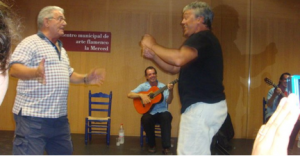
Bulerías de Cádiz: John Moore with an unknown dancer and singer Nani de Cádiz
I will close with one last tanguillo to bulerías transplant. This makes reference to the Rif War of 1883 where Berber groups, led by Maimón Mojetar, attacked the Spanish city of Melilla. It pokes fun at the beautification of the Cathedral square, comparing it to Melilla, and suggests that instead of Fray Silos Moreno (the cardinal who oversaw the completion of the cathedral), there should be a statue of Maimón Mojetar (later changed to ‘the sultan’). Again, this verse is attributed to Los Viejos Cooperativos, led by El Tío de la Tiza. The usual date is given as 1889, but I have also seen 1884, which seems to coincide better with the Rif War. The references to zoco (‘square’) and mezquita (‘mosque’) provide Northern African imagery, but also refer to two bars by those names that were near the square. Pericón discusses this verse as a tango de Carnaval and relates a series of hilarious stories about Cádiz Gitano Ignacio Espeleta in a theater production where he found his job challenging, despite only having to sing this tanguillo and one other thing. I have never heard this, nor any of the other bulerías verses mentioned here, sung as tanguillos – rather they have all passed into the bulerías repertoire.
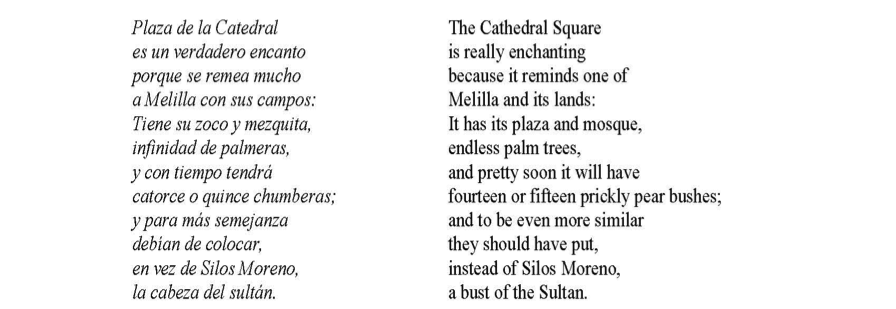
Cádiz is known throughout Spain for its humor, its poverty, and its Carnival. Within flamenco circles, it is known for a number of distinctive flamenco styles, including tanguillos and major-key bulerías. These are not accidental. The gracia gaditana, based on irony and gallows humor, is at the core of its Carnival, and has spilled over into its flamenco.
[1] The expression picha ‘dick’, pronounced [píʃa] in the local dialect (hence the pisha spelling), is a common term of address in Cádiz and the surrounding province, used in a manner similar to the American English term ‘dude’.


